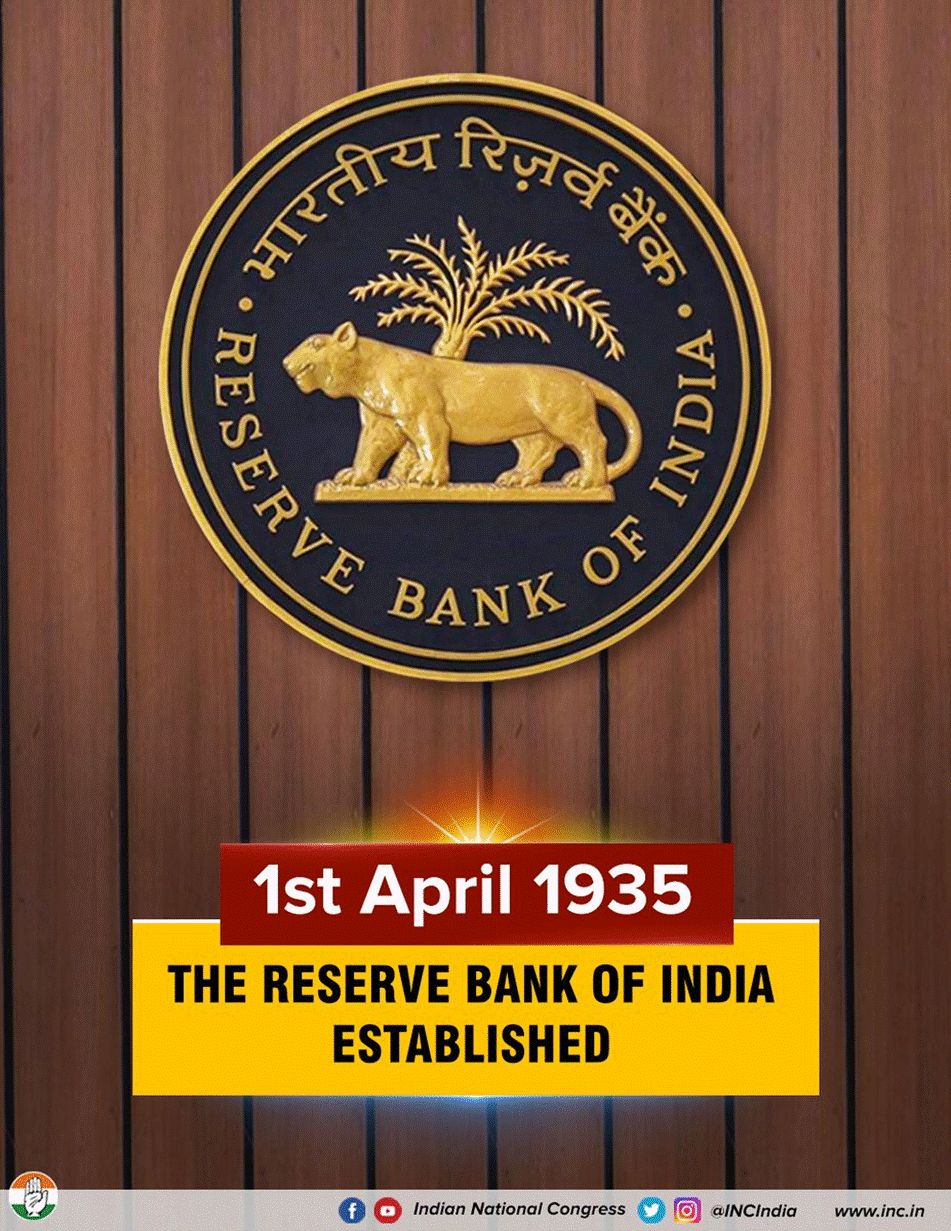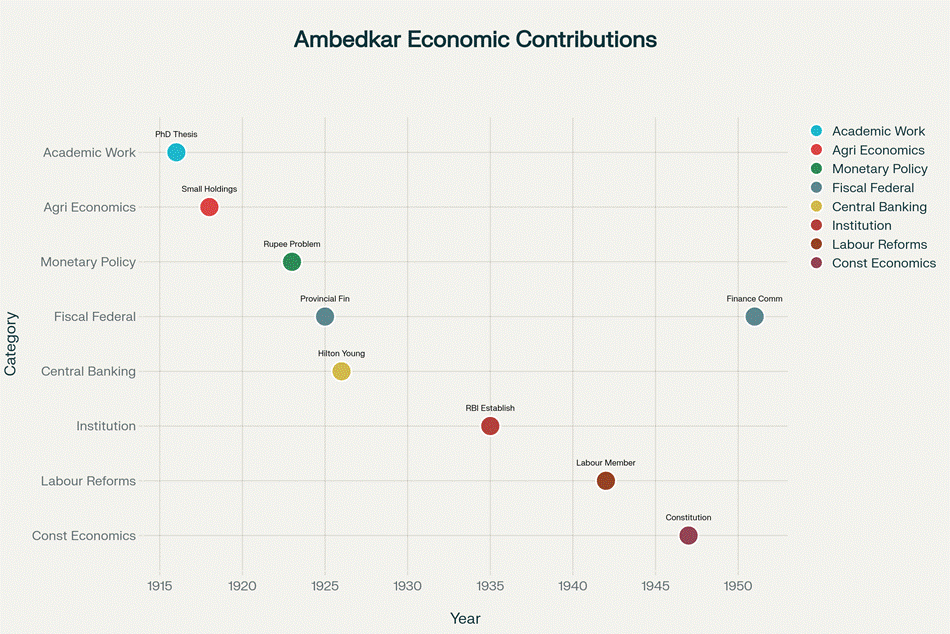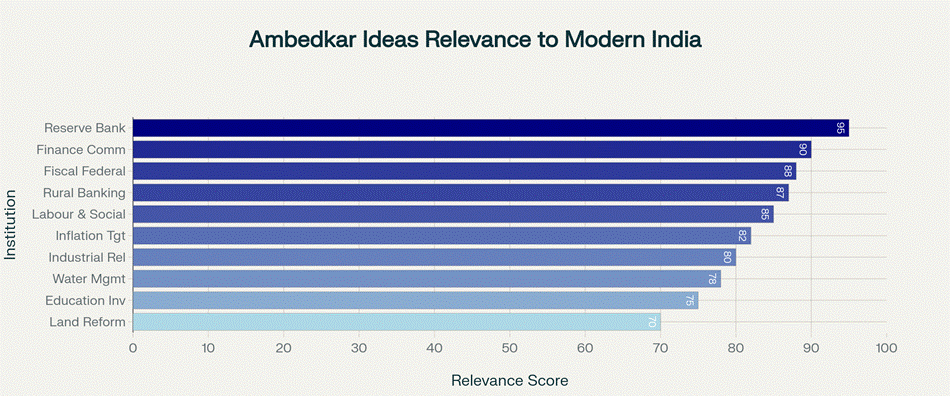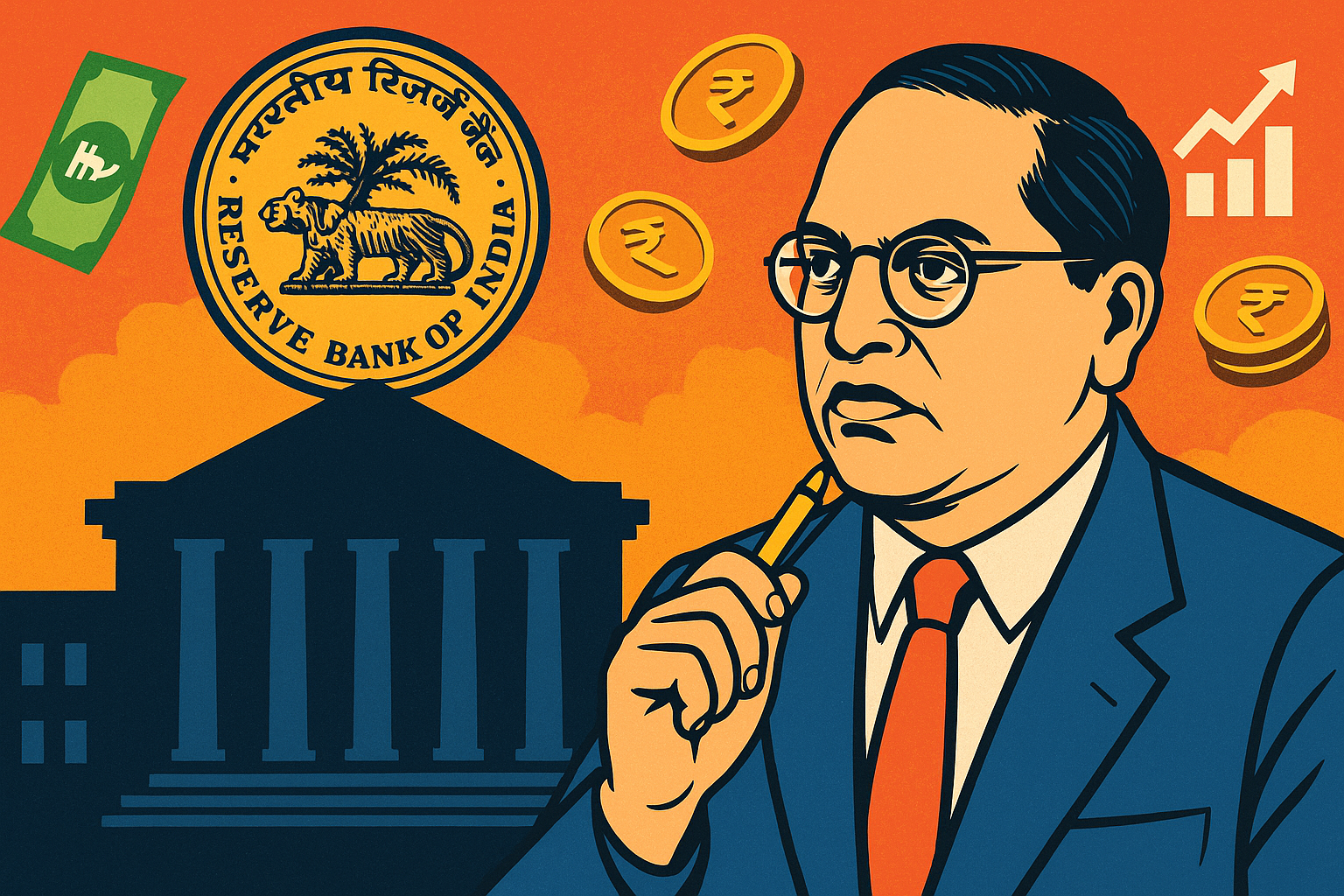The Reserve Bank’s Architect: Ambedkar’s Economic Statecraft and the Foundation of India’s Financial Institutions
Dr. Bhimrao Ramji Ambedkar’s role in shaping India’s economic architecture extends far beyond his celebrated contributions as the chief architect of the Indian Constitution. As a rigorously trained economist with doctorates from Columbia University and the London School of Economics, Ambedkar laid the intellectual and institutional foundations that would define India’s financial sovereignty and economic governance for generations to come. His visionary economic statecraft, articulated through seminal works like “The Problem of the Rupee: Its Origin and Its Solution” (1923), not only influenced the establishment of the Reserve Bank of India but also established principles of fiscal federalism, monetary stability, and inclusive development that continue to guide India’s economic policy framework today. [1][2][3]

The Reserve Bank of India was established on 1st April 1935, as shown by its official emblem and founding date.
The Monetary Visionary: From Colonial Critique to Central Banking
The Problem of the Rupee and Currency Sovereignty
Ambedkar’s journey as an economic architect began with his doctoral thesis at the London School of Economics, “The Problem of the Rupee: Its Origin and Its Solution,” submitted in 1923. This groundbreaking work represented far more than academic analysis—it was a scathing indictment of colonial monetary exploitation and a blueprint for India’s economic liberation. At a time when the Indian rupee was pegged to British interests and manipulated to favor colonial trade, Ambedkar exposed the systematic currency instability that plagued the Indian economy and undermined the purchasing power of ordinary citizens. [1][4][5][6][7]
The thesis demonstrated Ambedkar’s profound understanding of monetary economics, anticipating theoretical frameworks that would later be developed by Western economists. His analysis showed remarkable alignment with Irving Fisher’s quantity theory of money and Knut Wicksell’s natural rate of interest theory, yet was uniquely grounded in the socio-economic realities of colonial India. Unlike his contemporaries who focused primarily on trade benefits, Ambedkar emphasized the distributional consequences of exchange rate policy, arguing that monetary instability disproportionately harmed the poor and working classes through inflation and reduced real wages. [2][5][8]
Ambedkar’s preference for a limited devaluation of the rupee, balancing the interests of both business and earning classes, reflected his sophisticated understanding of economic justice. As he testified before the Royal Commission on Indian Currency and Finance, “The more important point is, supposing that there is a gain arising from low exchange, whence does this gain arise? It will at once become clear that this gain is not a gain coming to the nation from outside, but is a gain from one class at the cost of another class in the country”. [5][9][8]
The Hilton Young Commission and Institutional Genesis
The transformative impact of Ambedkar’s monetary analysis became evident when the Royal Commission on Indian Currency and Finance, known as the Hilton Young Commission, arrived in India in 1925-26. Every member of this commission carried a copy of Ambedkar’s book “The Problem of the Rupee,” testament to the work’s authoritative status in currency and finance discussions. Ambedkar’s detailed testimony before the commission, outlining his vision for monetary stability through a central banking institution, would prove instrumental in shaping the commission’s recommendations. [1][3][10][11][9]
The commission’s 1926 report, heavily influenced by Ambedkar’s framework, recommended the establishment of a central bank to address the dichotomy in currency and credit control that plagued British India. This recommendation culminated in the passage of the Reserve Bank of India Act in 1934 and the formal establishment of the RBI on April 1, 1935. While Ambedkar received no official recognition for his foundational role, the institutional DNA of the RBI bore the unmistakable imprint of his economic philosophy. [4][12][13][11][7][1]

Timeline of Dr. B.R. Ambedkar’s Key Economic Contributions (1916-1951)
Fiscal Federalism: Decentralization as Democratic Necessity
Provincial Finance and Constitutional Economics
Ambedkar’s second major contribution to India’s economic architecture came through his work “The Evolution of Provincial Finance in British India” (1925), which laid the theoretical foundation for fiscal federalism in independent India. Long before independence, Ambedkar recognized that centralized revenue collection exacerbated regional disparities and deprived provinces of the autonomy necessary for local development. His advocacy for decentralizing fiscal power to enhance regional economic equity proved remarkably prescient, anticipating the principles of fiscal federalism later formalized by economists like Richard Musgrave and Wallace Oates. [2][14][15]
Ambedkar’s vision for fiscal decentralization was not merely administrative but deeply democratic. He understood that without adequate financial resources, provincial governments could not effectively serve their constituents or address local development challenges. His proposal for a Finance Commission as a constitutional mechanism to ensure equitable distribution of resources between the center and states would later find expression in Article 280 of the Indian Constitution. [15][16]
The contemporary relevance of Ambedkar’s fiscal federalism is evident in India’s evolving federal structure. Statistical data reveals that state expenditure as a percentage of GDP has increased from 29% in 1950 to nearly 60% in 2022, validating Ambedkar’s principle of decentralization and the growing importance of states in economic governance. This trajectory reflects the enduring influence of his vision for cooperative federalism, where the central government would not monopolize financial power but would work in partnership with states for balanced national development. [2]
The Finance Commission Legacy
Ambedkar’s constitutional advocacy for the Finance Commission represents one of his most enduring institutional contributions. During the drafting of the Constitution, he argued passionately for this body as a mechanism to prevent fiscal centralization and ensure that states possessed adequate resources to fulfill their constitutional responsibilities. His understanding that “good administration depends upon good finance, for finance is the fuel of the whole administrative machine” became a guiding principle in India’s federal fiscal architecture. [17][15][18]
The successive Finance Commissions have operationalized Ambedkar’s vision through their evolving mandates and expanding scope. From the 1st Finance Commission’s focus on basic devolution to the 15th Finance Commission’s comprehensive approach encompassing GST compensation, local body grants, and performance-based incentives, each commission has built upon the foundational framework that Ambedkar envisioned. The Finance Commission’s role in addressing vertical and horizontal imbalances, promoting macroeconomic stability, and ensuring fiscal discipline reflects the sophisticated understanding of federal finance that Ambedkar brought to constitutional design. [15][16]
Labour Statecraft and Industrial Democracy
Revolutionary Labour Reforms
Ambedkar’s tenure as Labour Member of the Viceroy’s Executive Council from 1942 to 1946 marked a watershed moment in India’s industrial relations and social security framework. During this period, he introduced groundbreaking reforms that would establish the foundation for post-independence labour policy, including the 8-hour workday, equal pay for equal work, maternity benefits, and comprehensive social security provisions through the Employees’ State Insurance and Provident Fund systems. [2][19][20]
These labour reforms reflected Ambedkar’s broader economic philosophy that economic democracy—characterized by fair wages, social security, and worker rights—was essential for political democracy. His approach anticipated Amartya Sen’s later theories on development as freedom, recognizing that true liberation required not just political rights but economic empowerment and dignity. Unlike the trickle-down assumptions that informed much of early developmental economics, Ambedkar envisioned a bottom-up model of growth where the empowerment of the marginalized was both morally necessary and economically prudent. [2]
The contemporary relevance of Ambedkar’s labour vision is evident in modern India’s comprehensive labour codes and social security schemes. The Industrial Relations Code 2020, minimum wage laws, and expanded social security coverage for gig workers all trace their philosophical roots to the principles Ambedkar established during his transformative tenure as Labour Member.
His emphasis on worker dignity and economic justice continues to inform debates about decent work, income security, and the future of employment in India’s evolving economy.
Industrial Policy and State-Led Development
Ambedkar’s approach to industrialization was uniquely integrated with his vision of social transformation. He viewed industrial development not merely as economic necessity but as a tool for dismantling caste hierarchies and creating new patterns of social organization. His advocacy for state-led industrialization, collective farming, and public sector expansion reflected a systematic attempt to restructure the Indian economy from a feudal-colonial framework to one of participatory democracy and economic citizenship. [2][20][21]
In his work “States and Minorities” (1941), Ambedkar outlined a comprehensive vision of state socialism that placed the obligation on the state to plan economic life in ways that maximized productivity while ensuring equitable distribution of wealth. His proposals for nationalizing basic industries, agricultural land, and key infrastructure represented a bold alternative to both unfettered capitalism and authoritarian communism, advocating instead for democratic socialism guided by constitutional principles. [20][21]
Monetary Philosophy and Inflation Protection
Democratizing Finance for the Vulnerable
Ambedkar’s monetary philosophy was deeply rooted in the conviction that financial structures must serve the interests of the most economically vulnerable. His critique of monetary instability went beyond technical macroeconomic analysis to encompass moral and socio-political dimensions grounded in the lived experiences of laborers, peasants, and the working class. In “The Problem of the Rupee,” he emphasized that inflation functions regressively in developing economies, as those without capital reserves, wage indexation, or bargaining power bear the brunt of rising prices while their real incomes erode. [2][9][22][23]
This insight anticipated modern concerns about the distributional consequences of inflation, aligning Ambedkar more closely with institutional economists and early Keynesians who emphasized the real economy rather than abstract capital markets. His belief that financial stability must prioritize price controls to protect the poor parallels contemporary frameworks of inflation targeting with social safeguards, as practiced by modern welfare-oriented central banks. [2]
The Reserve Bank of India’s adoption of the Flexible Inflation Targeting Framework (FITF) in 2016, with its 4% inflation target and ±2% tolerance band, can be viewed as a longitudinal realization of Ambedkar’s early vision. By anchoring inflation expectations and shielding the population from destabilizing price volatility, especially those outside the formal financial sector, the FITF embodies the protective monetary philosophy that Ambedkar advocated nearly a century earlier. [23][2]

Relevance of Ambedkar’s Economic Ideas to Modern Indian Institutions
Contemporary Monetary Relevance
The enduring relevance of Ambedkar’s monetary thought is evident in the Reserve Bank of India’s evolution toward greater autonomy, transparency, and social responsibility. His emphasis on rule-based monetary management, cautioning against discretionary interventions while advocating for automatic monetary adjustments tied to economic fundamentals, finds expression in contemporary debates about central bank independence and inflation targeting frameworks. [23]
Modern central banking practices increasingly recognize the social dimensions of monetary stability that Ambedkar identified. The RBI’s expanded mandate to include financial inclusion, employment considerations, and sustainable development reflects the broader vision of monetary governance that Ambedkar articulated, where central banks serve not merely as inflation fighters but as institutions committed to economic justice and inclusive growth. [2][23]
Agricultural Economics and Land Reform
Structural Transformation Through Land Policy
Ambedkar’s engagement with agricultural economics, beginning with his 1918 paper “Small Holdings in India and Their Remedies,” demonstrated a sophisticated understanding of the relationship between land tenure, productivity, and social justice. He argued that the solution to India’s agricultural problems lay not merely in increasing farm sizes but in intensive cultivation supported by adequate capital and labor inputs, combined with cooperative farming arrangements. [24][25][26][27]
His analysis was remarkably prescient, anticipating by 36 years Arthur Lewis’s dual sector development model, for which Lewis received the Nobel Prize in Economics in 1979. Ambedkar’s insight that industrialization was “the soundest remedy for the agricultural problems of India” reflected his understanding that surplus agricultural labor needed alternative employment opportunities while remaining land required intensive cultivation with improved technology and cooperative organization. [25][24]
Ambedkar’s land reform philosophy was inextricably linked to his broader vision of social transformation. He proposed the nationalization of agricultural land and collective farming as mechanisms to break the monopoly of landlord classes while empowering historically marginalized communities. His advocacy for separate settlements for Downtrodden (Dalits) and the redistribution of government wasteland represented both economic policy and social liberation strategy, recognizing that land control was fundamental to caste oppression. [20][21][26]
Water Resources and Infrastructure Development
Ambedkar’s holistic approach to agricultural development extended to water resource management and infrastructure policy. As a member of the Viceroy’s Executive Council, he championed multi-purpose river valley projects like the Damodar and Hirakud Dams, viewing them as integrated solutions for irrigation, electricity generation, flood control, and regional development. This scientific outlook on infrastructure development reflected the post-war developmentalist state model and contributed significantly to India’s post-independence industrial and agricultural transformation. [2][28]
His vision for water resource management was both technical and social, recognizing that control over water resources was crucial for agricultural productivity and rural empowerment. The National Water Policy and contemporary debates about interlinking river projects continue to draw from the integrated approach to water management that Ambedkar pioneered.
Educational Economics and Human Capital Formation
Education as Economic Empowerment
Ambedkar’s commitment to education as a vehicle of economic empowerment was evident in his founding of institutions like the People’s Education Society and his persistent advocacy for technical and higher education. His emphasis on secular, scientific education directly challenged the caste monopoly over knowledge and sought to democratize access to learning as a foundation for economic participation. [2][20]
His educational philosophy anticipated human capital theory, recognizing that investment in education improved individual productivity and national income decades before Gary Becker formalized these concepts. Ambedkar’s advocacy for technical education, vocational training, and scientific inquiry reflected his understanding that knowledge was power and that educational access was fundamental to economic justice. [2]
The contemporary relevance of Ambedkar’s educational vision is evident in policies like the National Education Policy 2020, with its emphasis on technical education, skill development, and inclusive access. His insight that educational empowerment was prerequisite to economic empowerment continues to inform India’s approach to human capital development and inclusive growth.
Global Relevance and Contemporary Parallels
International Alignment with Development Goals
Ambedkar’s economic philosophy demonstrates remarkable alignment with contemporary global standards, particularly the United Nations Sustainable Development Goals. His focus on universal education, dignified work, equitable income distribution, and institution-building resonates strongly with SDG frameworks related to poverty reduction, decent work and economic growth, and reduced inequalities. [2]
His insistence on evidence-based policy, participatory governance, and state accountability mirrors global best practices in developmental economics and public administration. Moreover, Ambedkar’s approach to economic justice provides valuable lessons for developing nations grappling with inequality and social exclusion, offering alternatives to both neoliberal market fundamentalism and authoritarian state control. [2]
Lessons for Contemporary Economic Policy
The intellectual sophistication of Ambedkar’s economic thought, combining classical theory with indigenous realities, makes his work particularly relevant in contemporary post-colonial discourse. His hybrid approach, critically adapting Western economic models to Indian contexts while maintaining focus on justice and inclusion, offers important insights for modern policymakers seeking context-specific development strategies. [2]
Countries across the Global South, from South Africa to Brazil to the Philippines, can draw from Ambedkar’s model of integrating economic justice into policy design. His vision of democratic socialism, fiscal federalism, and inclusive development provides frameworks for addressing persistent challenges of inequality, regional imbalance, and social exclusion that continue to plague developing economies. [2]
Conclusion: The Enduring Architecture of Economic Justice
Dr. B.R. Ambedkar’s role as the Reserve Bank’s architect extends far beyond his contribution to India’s central banking institution. His comprehensive economic statecraft encompassed monetary policy, fiscal federalism, labour rights, agricultural development, and educational empowerment, creating an integrated framework for economic justice that continues to influence India’s development trajectory. From the Reserve Bank of India’s inflation-targeting framework to the Finance Commission’s role in federal resource distribution, from comprehensive labour codes to financial inclusion initiatives, the institutional DNA of modern India bears the indelible imprint of Ambedkar’s economic vision. [1][2]
His work represents a rare confluence of technical expertise and ethical commitment, demonstrating that economic policy must serve not merely efficiency but justice, dignity, and democratic empowerment. As India continues its journey toward becoming a developed economy while addressing persistent inequalities and regional disparities, Ambedkar’s economic philosophy provides both historical foundation and contemporary guidance for building a more inclusive and equitable future.
The relevance of Ambedkar’s economic thought transcends national boundaries, offering valuable insights for the global community’s ongoing struggles with inequality, financial instability, and sustainable development. His vision of economic statecraft—grounded in institutional integrity, social justice, and democratic participation—remains as vital today as it was nearly a century ago, continuing to inspire policymakers, economists, and social reformers committed to building more just and prosperous societies.
- https://en.themooknayak.com/bahujan-nayak/dalit-history-month-dr-ambedkars-significant-role-in-establishing-the-reserve-bank-of-india
- https://ssjar.singhpublication.com/index.php/ojs/article/download/236/478/617
- https://drambedkarbooks.com/2012/06/17/dr-b-r-ambedkar-on-indian-currency-and-rbi/
- https://dalittimes.in/dr-b-r-ambedkar-and-the-reserve-bank-of-india-the-forgotten-intellectual-architect/
- https://www.ijnrd.org/papers/IJNRD2207075.pdf
- https://www.allaboutambedkaronline.com/post/a-critical-overview-of-the-problem-of-the-rupee
- https://en.themooknayak.com/bahujan-nayak/100-years-of-the-problem-of-rupee-dr-br-ambedkars-historic-thesis-shapes-indias-economic-future
- https://organiser.org/2024/12/15/269185/bharat/the-rupee-saga-relevance-of-ambedkars-economic-thought-after-100-years/
- https://egyankosh.ac.in/bitstream/123456789/75097/1/Unit-7.pdf
- https://drambedkarbooks.com/wp-content/uploads/2009/03/statement-of-evidence-to-the-royal-commission-on-indian-currency.doc
- https://velivada.com/2017/04/01/dr-ambedkars-role-in-the-formation-of-reserve-bank-of-india/
- https://www.thedemocrat.in/india/the-vision-and-policies-of-dr–babasaheb-ambedkar-behind-the-establishment-of-the-reserve-bank/article-15726
- https://civils.pteducation.com/2021/09/UPSC-IAS-exam-preparation-Establishment-of-the-RBI.html
- https://ssjar.singhpublication.com/index.php/ojs/article/download/236/479?inline=1
- https://www.jetir.org/papers/JETIR2207032.pdf
- https://nipfp.org.in/media/medialibrary/2019/01/WP_252_2019.pdf
- https://www.drbrambedkarcollege.ac.in/uploads/publications/Academia-The Rising India & Economic Thinking of Dr Ambedkar.pdf
- https://www.drishtiias.com/daily-updates/daily-news-analysis/css-and-fiscal-federalism
- https://blog.lukmaanias.com/2025/04/21/dr-b-r-ambedkar-the-architect-of-modern-india-his-ideology-struggle-and-enduring-relevance/
- https://www.isca.in/IJSS/Archive/v2/i8/6.ISCA-IRJSS-2013-113.pdf
- https://www.ijfmr.com/papers/2024/4/24174.pdf
- https://euroasiapub.org/wp-content/uploads/134Nov17DhaniIJMR.pdf
- https://www.aarhat.com/download-article/4056/
- https://azimpremjiuniversity.edu.in/indian-economists/b-r-ambedkar
- https://www.onlineresearchjournals.com/aajoss/art/60.pdf
- https://ras.org.in/index.php?Article=b_r_ambedkar_on_caste_and_land_relations_in_india
- https://www.roundtableindia.co.in/long-neglected-ambedkar-s-philosophy-on-land-reform-and-agricultural-development/
- https://ambedkarinternationalcenter.org/2020/11/dr-b-r-ambedkar-a-veritable-phenomenon/
- https://www.historyjournal.net/article/460/7-7-11-949.pdf
- https://www.cprgindia.org/wp-content/uploads/2024/01/Economic-Thought-of-Ambedkar-and-Gandhi.pdf
- https://www.nextias.com/blog/dr-br-ambedkar/
- https://timesofindia.indiatimes.com/city/hyderabad/ambedkar-founded-rbi-finance-panel-that-saved-india-from-economic-collapse/articleshow/109296320.cms
- https://egyankosh.ac.in/handle/123456789/48759
- https://www.civilsdaily.com/news/90-years-of-the-reserve-bank-of-india-rbi/
- https://www.hcindiabrunei.gov.in/page/high-commission-remembers-dr-bhim-rao-ambedkar-the-architect-of-the-indian-constitution/
- https://www.roundtableindia.co.in/dr-b-r-ambedakar-his-economic-philosophy-and-state-socialism/
- https://www.instagram.com/p/DH5I_eiTXFe/?hl=en
- https://www.drishtiias.com/loksabha-rajyasabha-discussions/perspective-the-legacy-of-baba-saheb-ambedkar
- https://gipe.ac.in/wp-content/uploads/2025/02/Updated-Dr-Ambedkar-Conference-with-BARTI-Concept-Note.pdf
- https://mea.gov.in/Images/attach/amb/Volume_06.pdf
- https://developingeconomics.org/2025/07/08/more-than-100-years-of-ambedkars-the-problem-of-the-rupee-insights-ideas-and-intellectual-rigour-still-awaiting-discovery/
- https://www.openicpsr.org/openicpsr/project/152064/view
- https://www.marxists.org/archive/ambedkar/2015.84521.The-Problem-Of-The-Rupee-Its-Origin-And-Its-Solution_text.pdf
- https://spentamultimedia.com/flipbooks/dr-ambedkar/english/files/assets/common/downloads/page0058.pdf
- https://oldror.lbp.world/UploadedData/5847.pdf
- https://www.theindiaforum.in/article/fiscal-federalism-india
- https://www.newindianexpress.com/web-only/2023/Apr/14/remembering-ambedkar-the-accomplished-economist-2565895.html
- https://www.sriramsias.com/upsc-daily-current-affairs/ambedkars-economic-thinking-and-the-rupee-question/
- https://ijarsct.co.in/Paper2234.pdf
- https://www.historyjournal.net/archives/2025.v7.i7.A.460
- https://www.gucdoe.in/sites/default/files/POL_2026_B3.pdf
- https://www.ijfmr.com/papers/2023/5/6461.pdf
- https://ppl-ai-code-interpreter-files.s3.amazonaws.com/web/direct-files/99cc2660e36277c970abdd4a71c7adbf/6806f844-48b8-4708-bc36-fdc6acaab603/b65a4551.csv
- https://ppl-ai-code-interpreter-files.s3.amazonaws.com/web/direct-files/99cc2660e36277c970abdd4a71c7adbf/acd5e75f-5fdd-4fec-92e9-a4e7d4e002c4/0354a666.csv



















